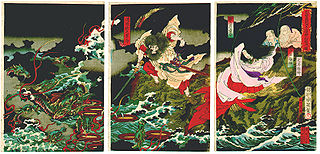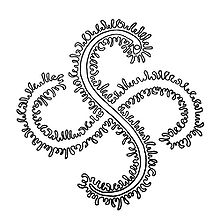
Hadad, Haddad, Adad, or Iškur (Sumerian) was the storm and rain god in the Canaanite and ancient Mesopotamian religions. He was attested in Ebla as "Hadda" in c. 2500 BCE. From the Levant, Hadad was introduced to Mesopotamia by the Amorites, where he became known as the Akkadian (Assyrian-Babylonian) god Adad. Adad and Iškur are usually written with the logogram 𒀭𒅎dIM—the same symbol used for the Hurrian god Teshub. Hadad was also called Pidar, Rapiu, Baal-Zephon, or often simply Baʿal (Lord), but this title was also used for other gods. The bull was the symbolic animal of Hadad. He appeared bearded, often holding a club and thunderbolt while wearing a bull-horned headdress. Hadad was equated with the Greek god Zeus, the Roman god Jupiter, as well as the Babylonian mythology Bel.

Chinese mythology is mythology that has been passed down in oral form or recorded in literature throughout the area now known as Greater China. Chinese mythology encompasses a diverse array of myths derived from regional and cultural traditions. Populated with engaging narratives featuring extraordinary individuals and beings endowed with magical powers, these stories often unfold in fantastical mythological realms or historical epochs. Similar to numerous other mythologies, Chinese mythology has historically been regarded, at least partially, as a factual record of the past.

Yamata no Orochi, or simply Orochi (大蛇), is a legendary eight-headed and eight-tailed Japanese dragon/serpent.

Proto-Indo-European mythology is the body of myths and deities associated with the Proto-Indo-Europeans, speakers of the hypothesized Proto-Indo-European language. Although the mythological motifs are not directly attested – since Proto-Indo-European speakers lived in preliterate societies – scholars of comparative mythology have reconstructed details from inherited similarities found among Indo-European languages, based on the assumption that parts of the Proto-Indo-Europeans' original belief systems survived in the daughter traditions.

The mythology of the ancient Basques largely did not survive the arrival of Christianity in the Basque Country between the 4th and 12th century AD. Most of what is known about elements of this original belief system is based on the analysis of legends, the study of place names and scant historical references to pagan rituals practised by the Basques.

In various Asian religious traditions, the Nagas are a divine, or semi-divine, race of half-human, half-serpent beings that reside in the netherworld (Patala), and can occasionally take human or part-human form, or are so depicted in art. A female naga is called a Nagi, or a Nagini. Their descendents are known as Nagavanshi. According to legend, they are the children of the sage Kashyapa and Kadru. Rituals devoted to these supernatural beings have been taking place throughout South Asia for at least 2,000 years. They are principally depicted in three forms: as entirely human with snakes on the heads and necks, as common serpents, or as half-human, half-snake beings in Hinduism, Buddhism, and Jainism.

Akelarre is the Basque term meaning Witches' Sabbath. Akerra means male goat in the Basque language. Witches' sabbaths were envisioned as presided over by a goat.

Mari, also called Mari Urraca, Anbotoko Mari, and Murumendiko Dama, is the main goddess of the pre-Christian Basque mythology. She is married to the god Sugaar. Legends connect her to the weather: when she and Maju travel together hail will fall, her departures from her cave will be accompanied by storms or droughts, and which cave she lives in at different times will determine dry or wet weather: wet when she is in Anboto; dry when she is elsewhere. Other places where she is said to dwell include the chasm of Murumendi, the cave of Gurutzegorri (Ataun), Aizkorri and Aralar, although it is not always possible to be certain which Basque legends should be considered as the origin.

The kulshedra or kuçedra is a water, storm, fire and chthonic demon in Albanian mythology and folklore, usually described as a huge multi-headed female serpentine dragon. The kulshedra is believed to spit fire, cause drought, storms, flooding, earthquakes and other natural disasters against mankind. In Albanian mythology she is usually fought and defeated by a drangue, a semi-human winged divine hero and protector of mankind. One of her greatest fights was against the daughter of the Sun deity and the Moon deity who tried to protect her loved one by using her powers. Heavy thunderstorms are thought to be the result of most of their battles. Others include earthquakes, volcanic eruptions and cyclones.

Armenian mythology originated in ancient Indo-European traditions, specifically Proto-Armenian, and gradually incorporated Hurro-Urartian, Mesopotamian, Iranian, and Greek beliefs and deities.

Mundaka is a town and municipality located in the province of Biscay, in the autonomous community of Basque Country, in northern Spain. Mundaka is internationally renowned for the surfing community that takes advantage of its coast and unique oceanic conditions.
Jaun Zuria is the mythical first Lord and founder of the Lordship of Biscay, who defeated the Leonese and Asturian troops in the also-mythical Battle of Padura, in which he chased off the invaders to the Malato Tree, establishing there the borders of Biscay. There are three accounts of its legend, one by the Portuguese count Pedro Barcelos and two by the chronicler Lope García de Salazar. According to the legend, Jaun Zuria had been born from a Scottish or English princess who had been visited by the Basque deity Sugaar in the village of Mundaka.
Herensuge is the name for a mythical dragon in the Basque language. In Basque mythology, dragons appear sparingly, sometimes with seven heads. Herensuge often also appear in the form of a serpent. The seven heads were believed to be the offspring of the Herensuge dragon. When the little dragons were fully grown, they would fall off their mother's head. Only the god Sugaar is associated with this creature but more often with a serpent.

As polytheistic systems evolve, there is a tendency for one deity to achieve preeminence as king of the gods. This tendency can parallel the growth of hierarchical systems of political power in which a monarch eventually comes to assume ultimate authority for human affairs. Other gods come to serve in a Divine Council or pantheon; such subsidiary courtier-deities are usually linked by family ties from the union of a single husband or wife, or else from an androgynous divinity who is responsible for the creation.
Sorginak are the assistants of the goddess Mari in Basque mythology. It is also the Basque name for witches, priests and priestesses, making it difficult to distinguish between the mythological and real ones.

A weather god or goddess, also frequently known as a storm god or goddess, is a deity in mythology associated with weather phenomena such as thunder, snow, lightning, rain, wind, storms, tornadoes, and hurricanes. Should they only be in charge of one feature of a storm, they will be called after that attribute, such as a rain god or a lightning/thunder god. This singular attribute might then be emphasized more than the generic, all-encompassing term "storm god", though with thunder/lightning gods, the two terms seem interchangeable. They feature commonly in polytheistic religions, especially in Proto-Indo-European ones.

Chinese gods and immortals are beings in various Chinese religions seen in a variety of ways and mythological contexts.














